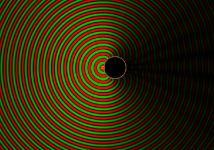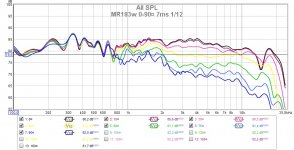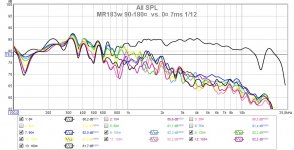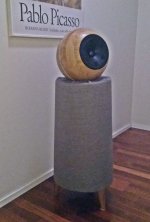That's right yes. As can be seen in my thread about the torus, if the diffractions can be smeared in time and space the peaks and nulls can be mitigated to a degree. The damping is probably having a similar effect.
Does this mean you are trying to prevent the front and rear interacting? In what way?If front cone side response is affected with radiation from rear side of cone then it is called dipole pekas and miniumums.
No. I try to make interacting spread over some range evenly. It mean not to have so significant dipole peaks and minimums or as less as is possible.
Something as with torus form here Did Siegfried Linkwitz miss a trick? or flower form her Did Siegfried Linkwitz miss a trick? but with U-frame and in lower frequencies.
Something as with torus form here Did Siegfried Linkwitz miss a trick? or flower form her Did Siegfried Linkwitz miss a trick? but with U-frame and in lower frequencies.
Last edited:
Does this help? :Did I understand diffraction wrong, if I interpret it on speakers in way that diffraction is happening with radiation of same speaker cone side. If front cone side response is affected with radiation from rear side of cone then it is called dipole pekas and miniumums.
"Assume a small unenclosed piston source in the center of a circular, flat baffle. The source radiates towards the front and with opposite polarity towards the back. A pressure increase in front is associated with a pressure decrease in back of the baffle. Observing again the response to a stepwise increase in pressure at some on-axis distance in front of the baffle, we see the initial pressure increase, which drops to 1/2 when the edge diffracted front side wave arrives. At the same time we also receive from the backside of the baffle that 1/2 portion of the wave, which was diffracted around the baffle edge into the frontal hemisphere. The 1/2 of the backside wave is of opposite polarity to the front wave and together with the front edge diffraction cancels the front wave completely(!)."
From here Frequently Asked Questions
Edge diffraction is reduced (eliminated?). There is still interference due to diffraction around the baffle, this can be smoothed by varying the path length.
Can you explain this, how diffraction can happen over circle(round body)?There is still interference due to diffraction around the baffle, this can be smoothed by varying the path length.
This is very general case.
But how with speaker bodies?
I found this What Do Roundovers Do? where with sphere speaker body diffraction nearly missing,
But how with speaker bodies?
I found this What Do Roundovers Do? where with sphere speaker body diffraction nearly missing,
That's a pretty good, easily understood post. He's talking about monopoles of course. When Linkwitz speaks of the diffracted wave from the rear side coming around to the front would it make more sense if he called it baffle step? 😉
Last edited:
If speaker body is sphere from front to rear and from rear to front, then also rear to front diffraction is missing?
The edge diffraction will be missing. This is something where Linkwitz's views on the audibility of baffle edge diffraction seem a little ambiguous to me.
Sound will still travel around the baffle it just won't appear as a separate source at the edge. This diffraction (baffle step if you like) is what causes the interference which creates the dipolar response.
Sound will still travel around the baffle it just won't appear as a separate source at the edge. This diffraction (baffle step if you like) is what causes the interference which creates the dipolar response.
The sphere supports much diffraction but does it in a preferrable way. If you place your head in the speaker position and look out, you cannot see around the curved sides to behind the cabinet. Sound will diffract there.
This post does not show diffraction... it shows the frequency response that you see from on-axis resulting from diffraction. This does not mean there is more or less diffraction, all the cabinets are similar in the bigger picture.I found this What Do Roundovers Do? where with sphere speaker body diffraction nearly missing,
Sound can travel in a straight direction away from the driver. On the other hand, sound behind a cabinet comes from sound already part-way around the cabinet..
I made ball speakers with SEAS MR18 coaxial and it measures like this (indoor with some reflections) with eq and xo applied: Pretty good, but basically it's frontal radiation is same as a nude driver (ie. no baffle gain)
Gradient 1.4 was the last speaker by Jorma Salmi High Fidelity
Gradient 1.4 was the last speaker by Jorma Salmi High Fidelity
An externally hosted image should be here but it was not working when we last tested it.
Attachments
Last edited:
Probably I mean here only very narrow panel diffraction but other mean diffraction in all his wide meaning. Any way this is phenomenon what must be considered also building rounded baffle OB speakers.
Some dismiss baffle edge diffraction in OB speakers, in my thread, for example Charlie Laub said he liked to think it cancels out at the edge. Linkwitz thinks otherwise, and his measurements seem to show it doesn't, I think the simulations also show it doesn't.
Diffraction must be present at least in Akabak simulation, but it is difficult to separate just radiation and diffracted radiation.
I little look at Ripple tank simulations and find point source there is not actually point, but rectangular and creates diffraction without any obstacle.
I little look at Ripple tank simulations and find point source there is not actually point, but rectangular and creates diffraction without any obstacle.
Last edited:
- Home
- Loudspeakers
- Multi-Way
- Open baffle MTM questions




